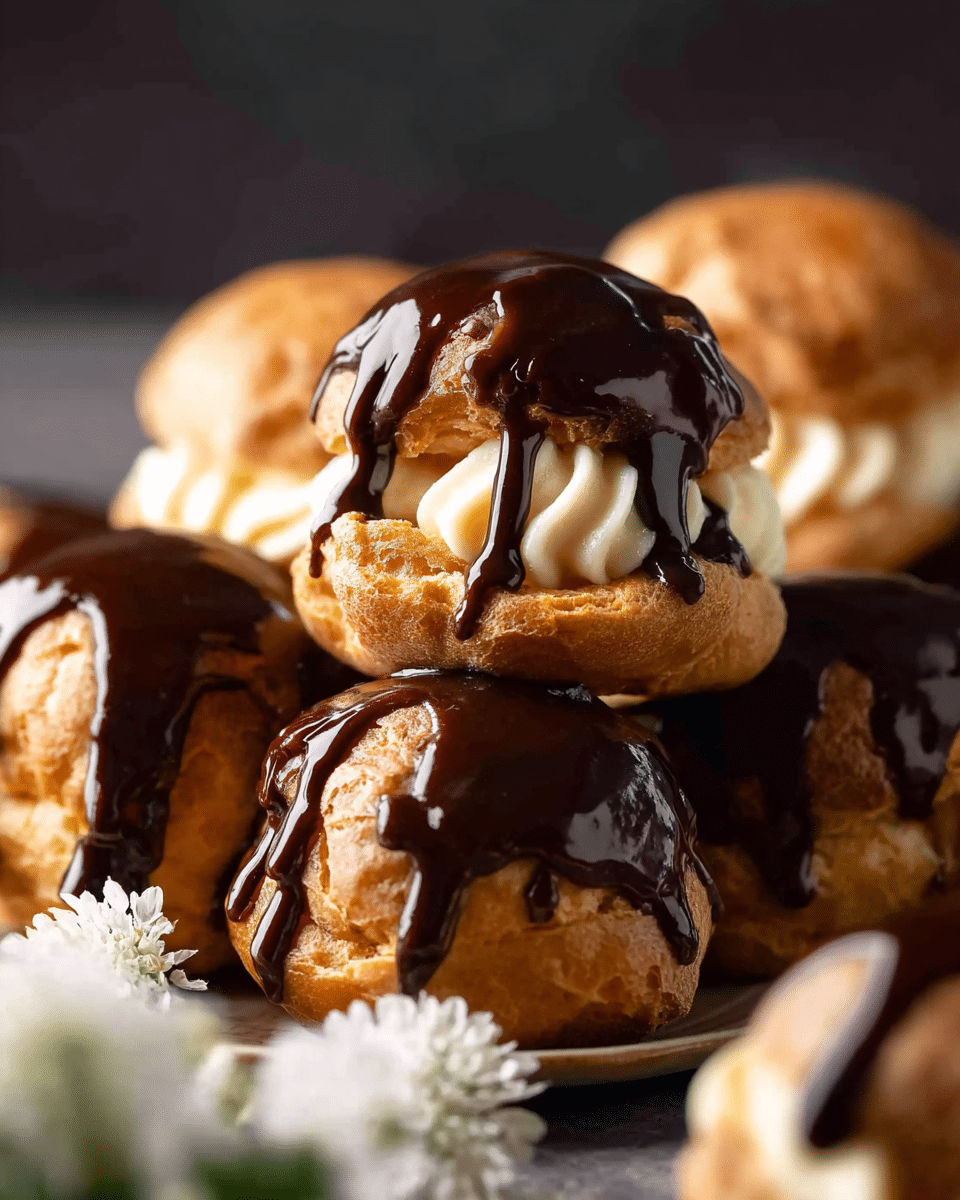These Profiteroles are the perfect bite-sized indulgence—crisp golden pastry shells filled with silky smooth vanilla custard, topped with a dreamy drizzle of chocolate ganache. The texture play between the airy shell, creamy center, and rich chocolate is nothing short of magical.
Perfect for gatherings or an elevated dessert spread, these little pastries are deceptively simple to make but bring a touch of Parisian bakery charm to your kitchen. You can make the shells ahead of time, refrigerate the filling, and assemble just before serving for maximum freshness and show-stopping flair.
Full Recipe:
Choux Pastry:
-
100g (7 tbsp) unsalted butter
-
1 cup water
-
1 cup all-purpose flour
-
4 large eggs (55–60g with shell)
-
Pinch of salt
Custard Filling (Crème Pâtissière):
-
4 egg yolks
-
1/4 cup caster sugar
-
3 1/2 tbsp cornstarch
-
2 1/3 cups whole milk
-
1/4 cup extra caster sugar
-
1 tsp vanilla bean paste (or extract)
Chocolate Sauce:
-
250g (8 oz) dark or semi-sweet chocolate
-
1 cup heavy cream
Directions:
-
Make the Pastry Shells:
In a saucepan over medium heat, melt butter. Add water and bring to a rapid simmer. Add flour and salt, stir vigorously for about 1 minute until it forms a dough ball. Remove from heat and let cool for 10 minutes. -
Preheat oven to 220°C/420°F (200°C fan). Lightly grease and line 2-3 baking trays.
-
Add eggs one at a time to the cooled dough, mixing well after each addition until smooth.
-
Transfer to a piping bag with a 1/2-inch tip. Pipe 2-teaspoon-sized mounds 2 inches apart. Wet fingers and pat down peaks.
-
Bake for 15 minutes, rotating trays halfway. Lower oven to 180°C/350°F (160°C fan), pierce each puff with a knife, return to oven for 5–7 minutes until golden and crispy.
-
Cool on rack before filling.
Make the Custard:
-
Whisk yolks and 1/4 cup sugar until pale. Add cornstarch, mix well.
-
Heat milk, vanilla, and extra sugar until just before boiling. Temper egg mixture with 1/2 cup of the hot milk, then add remaining.
-
Return to saucepan on low-medium heat, whisk constantly for 2–3 minutes until thick.
-
Transfer to bowl, press cling wrap onto surface, chill 4–5 hours.
Make the Chocolate Sauce:
-
Combine cream and chocolate in a heatproof bowl. Microwave in 30-second intervals, stirring in between, until smooth. Let cool slightly before drizzling.
Assemble:
Fill cooled pastry with custard using a piping bag fitted with a fine nozzle. Drizzle with warm chocolate sauce before serving.
Prep Time: 25 minutes | Cooking Time: 30 minutes | Total Time: 55 minutes
Kcal: 101 kcal per serving | Servings: 48 profiteroles
The Delightful World of Profiteroles
Profiteroles, also known as cream puffs, are a classic French dessert made of light and airy choux pastry filled with a sweet center—most often whipped cream, custard, or ice cream—and traditionally topped with a rich chocolate sauce. These bite-sized desserts are elegant, versatile, and surprisingly achievable even for home bakers. Profiteroles have stood the test of time as a crowd-pleasing favorite at gatherings, dinner parties, and festive occasions.
A Brief History of Profiteroles
The origins of profiteroles can be traced back to the 16th century, when Catherine de Medici of Italy married King Henry II of France. She brought with her Italian chefs and pastry techniques that would later evolve into French culinary traditions. It was during this cultural fusion that choux pastry—or pâte à choux—was born, laying the foundation for many iconic pastries including éclairs, croquembouche, and of course, profiteroles.
Over time, French pastry chefs refined the recipe, elevating the humble cream puff to the fine-dining staple we know today. Profiteroles have since traveled across borders and evolved into different versions, but the French interpretation remains the most revered.
Understanding Choux Pastry
The foundation of profiteroles is the choux pastry, a dough unlike any other in the baking world. It uses simple ingredients—typically butter, water, flour, and eggs—but the magic lies in the method. Unlike yeast-based doughs or cake batters, choux is first cooked on the stovetop, then baked. This cooking process evaporates moisture, creating a dough that puffs up beautifully in the oven to form a hollow center—perfect for fillings.
What sets choux apart is that it doesn’t use any chemical leavening agents like baking powder. The rise comes entirely from steam generated during baking, which forces the dough to expand and become crisp on the outside and hollow inside.
Tips for Perfect Profiteroles
While choux pastry is straightforward, there are several techniques that ensure success:
-
Cool the dough before adding eggs: This prevents the eggs from scrambling and allows them to incorporate smoothly into the batter.
-
Mix vigorously: Adding eggs will initially make the dough appear split, but continued mixing will emulsify it into a thick, glossy paste.
-
Pipe consistently sized rounds: This ensures even baking and a uniform look.
-
Double-bake method: After the initial bake, piercing and returning the puffs to the oven dries out the interior and adds extra crispness—key to preventing sogginess after filling.
With attention to these details, even novice bakers can achieve impressive results.
Common Profiterole Fillings
While whipped cream is a popular and fast filling, vanilla custard—also known as crème pâtissière—adds a deeper, more complex flavor. The custard is thick, creamy, and rich, complementing the lightness of the pastry perfectly. For a summer-friendly twist, ice cream is another delicious option, commonly used in American versions of the dessert.
Each filling offers a unique texture and experience:
-
Vanilla custard: Velvety and luxurious, it holds up well in advance preparation.
-
Whipped cream: Light and airy, ideal for quick assemblies.
-
Ice cream: Best served immediately to prevent melting; perfect for a frozen dessert.
The Art of Chocolate Topping
The final flourish of any profiterole is the chocolate drizzle. Traditionally, a warm ganache made from dark or semi-sweet chocolate and heavy cream is poured over the filled pastries. The sauce is silky and indulgent when warm, then sets to a soft, fudgy texture as it cools. This not only enhances the flavor but also adds an eye-catching glossy finish.
For variation, white chocolate or caramel can be used. Some modern chefs even infuse their chocolate sauce with liqueurs or espresso for an adult twist.
Make-Ahead Magic
Profiteroles are the perfect dessert to prepare ahead of time for stress-free entertaining. The choux shells can be made days—or even months—in advance and stored in an airtight container or frozen. They can be quickly revived with a few minutes in a hot oven to restore their crispness.
The custard or cream can also be prepped the day before and refrigerated. Simply assemble by filling and drizzling just before serving to keep everything fresh and delightful.
This make-ahead flexibility makes profiteroles not just delicious, but also convenient—a dream combination for hosts.
Serving Suggestions
Profiteroles are stunning on their own, but they can also be part of a more elaborate dessert presentation:
-
Croquembouche: A towering cone of profiteroles bound with caramel strands—ideal for weddings and celebrations.
-
Plated desserts: Serve 3 to 4 profiteroles per plate with fresh berries and a drizzle of extra chocolate sauce.
-
Mini dessert buffet: Include assorted profiterole fillings—custard, cream, ice cream—to offer guests variety.
To elevate your presentation, sprinkle the tops with powdered sugar, crushed nuts, or edible gold leaf for a gourmet touch.
Why Profiteroles Are Universally Loved
There’s something for everyone in a profiterole. Their small size makes them perfect for portion control, while the light pastry and customizable fillings appeal to a wide range of palates. Whether you enjoy them mildly sweet with whipped cream or decadently rich with custard and dark chocolate, profiteroles can be adapted to suit any taste or occasion.
Moreover, they bridge the gap between rustic comfort food and refined patisserie. They feel indulgent without being overly heavy, and they carry an air of elegance despite their humble ingredients.
Profiterole Variations Around the World
Though rooted in French cuisine, profiteroles have inspired many regional versions:
-
Italy: Known as bignè, often filled with pastry cream and coated in glaze.
-
Spain: Choux pastry forms the basis for buñuelos, sometimes filled and fried.
-
United States: Commonly served with ice cream and hot fudge as a plated dessert.
Each version brings its cultural touch, proving the global appeal of this airy pastry.
Profiteroles vs. Éclairs
While they share the same dough, the difference between profiteroles and éclairs lies in shape and often, filling. Profiteroles are small, round, and often filled from the side or bottom. Éclairs are longer, filled lengthwise, and topped with a glaze rather than a pourable sauce.
Both are staples of French patisserie and offer equally delicious results, though profiteroles tend to be more versatile for events due to their individual bite-size form.
Final Thoughts: The Timeless Elegance of Profiteroles
Profiteroles are proof that simple ingredients can produce extraordinary results when paired with the right techniques. Their delicate texture, customizable filling, and rich topping make them a showstopper dessert with broad appeal. Whether you’re planning a formal dinner, hosting friends, or looking for a new baking challenge, profiteroles deliver both flavor and finesse.
Not only are they beautiful to present, but they also invite creativity—offering endless room for customization in terms of fillings, sauces, and presentation styles. With a bit of practice and care, anyone can master this classic dessert and enjoy the admiration it inevitably draws.






